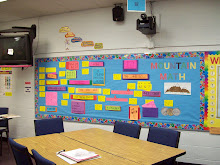Theory of Instruction and Theory of Learning are probably two entities that can be placed together and developed together. I understand that theory of instruction is how the teacher presents the information to the students and theory of learning is how the students receive the information from the teacher and I have not changed from that thought. Teachers are held to providing as many different ways to present information to students so that learning is meaningful, memorable and students can use it throughout their life. There are many people who have provided many studies toward this thinking, however, every student does not learn the same, and therefore, the teacher’s duty is to provide students with what is needed in order for learning to be all it can be for the student.
As we move toward an era where teachers will recognize more about differentiated instructional strategies, all the needs of students can and will be met.
I believe that theory of learning is most important but cannot function completely without the help of the theory of instruction. Again, it is how the teacher presents the information to the student that will become more meaningful to them. As we began to move into an era where technology is very important, students must have the knowledge of how and when to use technology. This is where the classroom comes in to play a vital role in this strategy. Students are very interested in technology and will probably display more knowledge that what we realize they will. The goal is to prepare the student for future use of technology in the classroom and in the real world. Technology will probably be the most important part of the world in about 5-10 years; therefore students need to be prepared for this transition.
My personal theory of learning is strongly linked to Differentiated Instructional teaching. Teachers can differentiate the content, the process, or the product. It matters how you present the information to the students because all students learn differently. Through this process, teachers must incorporate technology, because this is a strong area of differentiation. Technology can go in the area of content, process and product. I use technology a lot in my classroom. Some examples of technology usage in my classroom is individual laptops, my Smart Board, my Document Camera (The Elmo), in Science we use the video cameras and digital cameras. Students are allowed to work on different activities, video games, create projects and work with the teacher in small groups with the Smart Board.
Because I believe that all students learn differently, it is very important to me that I create lessons that are meaningful to the students. Howard Garner’s multiple intelligences play a great part in differentiated instruction, because we need to know each student, so as teachers we can meet their needs. Lever-Duffy & McDonald states, “The act of teaching requires an understanding of learning and an understanding of the individual and environmental factors that affect the learner. It also requires an understanding of yourself and the individual and environmental factors that affect you as a teacher.” So in conclusion, when I design lessons, I make sure I am meeting the needs of everyone of my students. I take time to learn my students and know their likes and dislikes. Mostly all of my students love technology, but I take into consideration their needs and I apply technology according to their needs. I am logical-mathematical, musical, bodily kinesthetic and interpersonal. This comes largely because I am a teacher, I was involved in music for the larger part of my life, I am the dance line coach at my school presently, I love to solve problems, I am a basketball coach during the school year and during the summer and I am a tactile and visual learner. Also, while working on my papers, I use music on my computer and listen to the television at the same time. So I am able to notice what my students like and do not like, therefore, I am able to meet their needs in the classroom.
My two personal goals are to integrate blogging for the means of assessment and thought from my students on what they are studying. Another long term goal is to allow technology play a higher role in my classroom as I realize that my students do indeed enjoy technology very much and look forward to learning from it. I have made a pact to with my Principal's approval to implement a Learning Cafe' at our school, therefore students are able to blog, collaborate with their classmates outside of school time, etc..... We will work hard to make plans to meet the needs of all students where ever needed. My outline is to strive to stick to my plan and meet the students where they are in their learning.
References:
Lever-Duffy, J. & McDonald, J. (2008). Theoretical Foundations (Laureate Education, Inc., custom ed.). Boston, MA: Pearson Education, Inc.
No Means NO!
9 years ago



